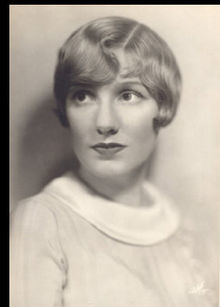- Marion Harris
-
Marion Harris 
Marion Harris in 1924Background information Birth name Mary Ellen Harrison Born April 4, 1896
Indiana, United StatesDied April 23, 1944 (aged 48)
New York CityGenres Jazz, blues, pop Occupations Singer Years active 1914—1930s Labels Victor, Columbia, Brunswick Marion Harris (April 4, 1896[1] — April 23, 1944)[2][3] was an American popular singer, most successful in the 1920s. She was the first widely known white singer to sing jazz and blues songs.[4]
Born Mary Ellen Harrison, probably in Indiana,[5] she first played vaudeville and movie theaters in Chicago around 1914. Dancer Vernon Castle introduced her to the theater community in New York where she debuted in a 1915 Irving Berlin revue, Stop! Look! Listen!
Contents
Recordings
In 1916, she began recording for Victor Records, singing a variety of songs, such as "Everybody's Crazy 'bout the Doggone Blues, But I'm Happy", "After You've Gone", "A Good Man Is Hard to Find" (later recorded by Bessie Smith), "When I Hear that Jazz Band Play" and her biggest success, "I Ain't Got Nobody".[6]
In 1920, after the Victor label would not allow her to record W.C. Handy's "St. Louis Blues", she joined Columbia Records where she recorded the song successfully. Sometimes billed as "The Queen of the Blues,"[4] she tended to record blues- or jazz-flavored tunes throughout her career. Handy wrote of Harris that "she sang blues so well that people hearing her records sometimes thought that the singer was colored."[7] Harris commented, "You usually do best what comes naturally, so I just naturally started singing Southern dialect songs and the modern blues songs."[8]
In 1922 she moved to the Brunswick label. She continued to appear in Broadway theatres throughout the 1920s. She regularly played the Palace Theatre, appeared in Florenz Ziegfeld's Midnight Frolic and toured the country with vaudeville shows.[2] After a marriage which produced two children, and her subsequent divorce, she returned in 1927 to New York theater, made more recordings with Victor and appeared in an eight-minute promotional film, Marion Harris, Songbird of Jazz. After a Hollywood movie, the early musical Devil-May-Care (1929) with Ramón Novarro, she temporarily withdrew from performing because of an undisclosed illness.
Radio
Between 1931 and 1933, when she performed on such NBC radio shows as The Ipana Troubadors and Rudy Vallee's The Fleischmann's Yeast Hour, she was billed by NBC as "The Little Girl with the Big Voice."[9]
In early 1931 she performed in London, returning for long engagements at the Café de Paris. In London she appeared in the musical Ever Green and broadcast on BBC radio. She also recorded in England in the early 1930s but retired soon afterwards and married an English theatrical agent. Their house was destroyed in a German rocket attack in 1941, and in 1944 she travelled to New York to seek treatment for a neurological disorder. Although she was discharged two months later, she died soon afterwards in a hotel fire that started when she fell asleep while smoking in bed.
References and notes
- ^ Her gravestone, as seen at Find-a-Grave [1], gives a birth date of 1906. This does not tally with all evidence elsewhere, which is that she was a young adult by 1914.
- ^ a b Marion Harris
- ^ Find-a-Grave states March 24, 1944.
- ^ a b Elijah Ward, Escaping The Delta, 2005, ISBN 978-0-06-052427-2
- ^ Find-a-Grave states Kentucky, but this is countered by evidence at The Jazz Age site [2]
- ^ Originally titled "I Ain't Got Nobody Much"
- ^ W.C. Handy, Father of the Blues, 1941
- ^ 1922 Columbia Records catalog, quoted in Elijah Ward, Escaping The Delta, 2005, ISBN 978-0-06-052427-2, p. 283.
- ^ Gracyk, Tim. The Encyclopedia of Popular American Recording Pioneers: 1895-1925. Routledge, 2000.
External links
Categories:- 1896 births
- 1944 deaths
- American blues singers
- American female singers
- American pop singers
- Vaudeville performers
Wikimedia Foundation. 2010.
